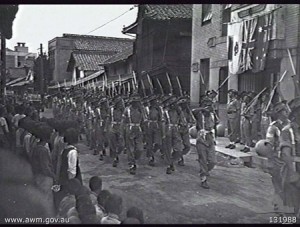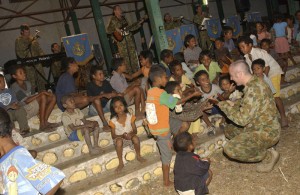Raising the Australian Regiment
A Regular Infantry Force for Australia
November marks the anniversary of the formation of the Australian Regiment, a significant event in the history of the post World War II Australian Army. The raising of this new regiment was the first step towards Australia having, for the first time, a regular force ready for any task in peace or war. There were, however, a number of issues to be addressed before this force could be assembled. Victory in Europe had led Australia to plan for a reduced force of three divisions to be available for operations by the end of 1945. With this force Australia prepared to participate in the invasion of Japan and contribute some forces to the recapture of Singapore. The unexpectedly sudden end to the war in the Pacific in August 1945 changed everything. Australia was faced with organising the surrender, processing and eventual repatriation of 344,000 Japanese in the army’s area of responsibility. More importantly, 20,000 liberated Australian POWs had to be returned home. Further complicating plans was demobilisation of personnel then serving in the South-West Pacific area and Australia, which had commenced six weeks after the end of hostilities. Despite these conflicting demands, the government was determined that Australia would have a prominent role in the proposed multi-national British Commonwealth Occupation Force (BCOF), planned as part of the occupation of Japan. It was decided that an entirely new formation, the 34th Brigade, comprised of three new battalions, the 65th, 66th and 67th Australian Infantry Battalions, would form the land element of the Australian force.
In September 1945 Advanced Land Headquarters on Morotai, one of the Moluccas group of islands, was authorised to raise the new brigade drawing on volunteers from the five infantry divisions that had fought against the Japanese. The 65th Battalion was formed from men of the 7th Division, then at Balikpapan. The 66th Battalion drew on the 9th Division in Borneo, while the 3rd, 6th and 11th Divisions, deployed at Bougainville, Wewak and Rabaul respectively, provided men for the 67th Battalion. The volunteers would serve for twelve months in Japan, on existing rates of pay and allowances. The concentration area would be on Morotai so the force could move quickly north to Japan.
The battalions were assembled at Morotai by early November and training began. However, delay in moving the force to Japan began to erode both morale and unit strength. By early December refusals to sign the undertaking for service in Japan and increasing requests for compassionate leave saw the brigade strength reduced by 2000 men. Realising that the occupation force could not be sustained by volunteers from existing formations in the forward area, general recruitment from the civilian population was introduced in 1946. Finally, in February 1946, shipping was organised and the Brigade Group (including my future father) sailed for Japan. By the end of the month the Australian contingent of BCOF was performing occupation duties.
Despite these conflicting demands, the government was determined that Australia would have a prominent role in the proposed multi-national British Commonwealth Occupation Force (BCOF), planned as part of the occupation of Japan. It was decided that an entirely new formation, the 34th Brigade, comprised of three new battalions, the 65th, 66th and 67th Australian Infantry Battalions, would form the land element of the Australian force.
In September 1945 Advanced Land Headquarters on Morotai, one of the Moluccas group of islands, was authorised to raise the new brigade drawing on volunteers from the five infantry divisions that had fought against the Japanese. The 65th Battalion was formed from men of the 7th Division, then at Balikpapan. The 66th Battalion drew on the 9th Division in Borneo, while the 3rd, 6th and 11th Divisions, deployed at Bougainville, Wewak and Rabaul respectively, provided men for the 67th Battalion. The volunteers would serve for twelve months in Japan, on existing rates of pay and allowances. The concentration area would be on Morotai so the force could move quickly north to Japan.
The battalions were assembled at Morotai by early November and training began. However, delay in moving the force to Japan began to erode both morale and unit strength. By early December refusals to sign the undertaking for service in Japan and increasing requests for compassionate leave saw the brigade strength reduced by 2000 men. Realising that the occupation force could not be sustained by volunteers from existing formations in the forward area, general recruitment from the civilian population was introduced in 1946. Finally, in February 1946, shipping was organised and the Brigade Group (including my future father) sailed for Japan. By the end of the month the Australian contingent of BCOF was performing occupation duties.
 In 1948 the decision to return two of the battalions to Australia prompted consideration of the organisation of the infantry in the peace time army. It was decided to adopt a regimental system with battalions numbered sequentially within one regiment. Hence, the 65th, 66th and 67th Battalions became the 1st, 2nd and 3rd Battalions of the Australian Regiment. Royal assent to the granting of the title ”Royal” in March 1949 brought into being The Royal Australian Regiment which continues today as Australia’s regular infantry regiment.
The Royal Australian Regiment has served Australia continuously since 1949, on operations and in peace keeping roles. We will consider some of these deployments in future occasional highlights.
Article written by Rod Margetts - who is a battlefield tour guide for Boronia Travel Centre.
Image Top Left (1946): Troops from the 34th Brigade march through Saijo. www.awm.gov.au
Image Bottom Right (Today): A musician from the First Battalion Royal Australian Regiment band entertains the local Moleana children with claves (wooden percussion sticks) during an impromptu concert. www.defence.gov.au
In 1948 the decision to return two of the battalions to Australia prompted consideration of the organisation of the infantry in the peace time army. It was decided to adopt a regimental system with battalions numbered sequentially within one regiment. Hence, the 65th, 66th and 67th Battalions became the 1st, 2nd and 3rd Battalions of the Australian Regiment. Royal assent to the granting of the title ”Royal” in March 1949 brought into being The Royal Australian Regiment which continues today as Australia’s regular infantry regiment.
The Royal Australian Regiment has served Australia continuously since 1949, on operations and in peace keeping roles. We will consider some of these deployments in future occasional highlights.
Article written by Rod Margetts - who is a battlefield tour guide for Boronia Travel Centre.
Image Top Left (1946): Troops from the 34th Brigade march through Saijo. www.awm.gov.au
Image Bottom Right (Today): A musician from the First Battalion Royal Australian Regiment band entertains the local Moleana children with claves (wooden percussion sticks) during an impromptu concert. www.defence.gov.au
This entry was posted in Historical Highlights. Bookmark the permalink.






